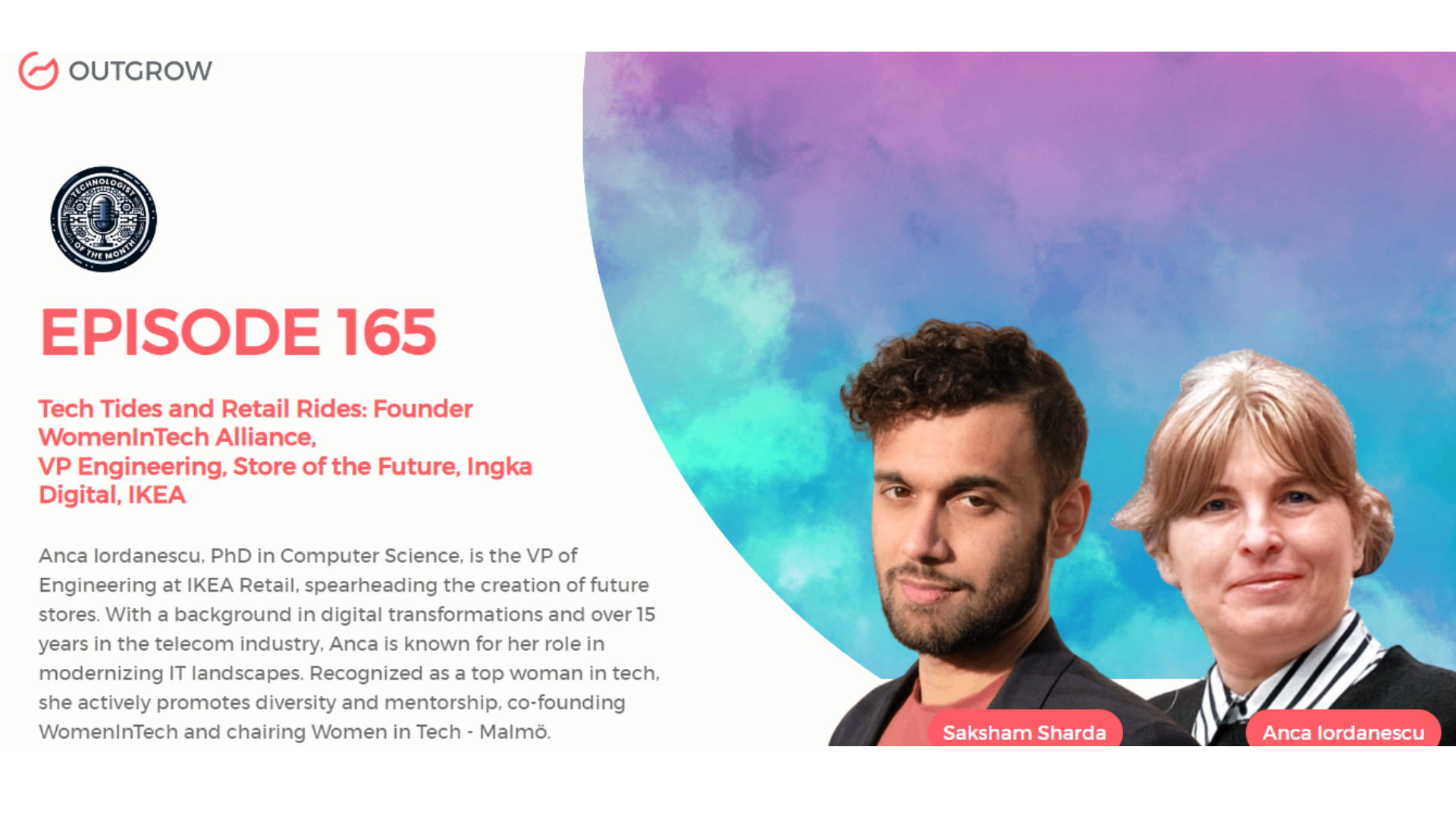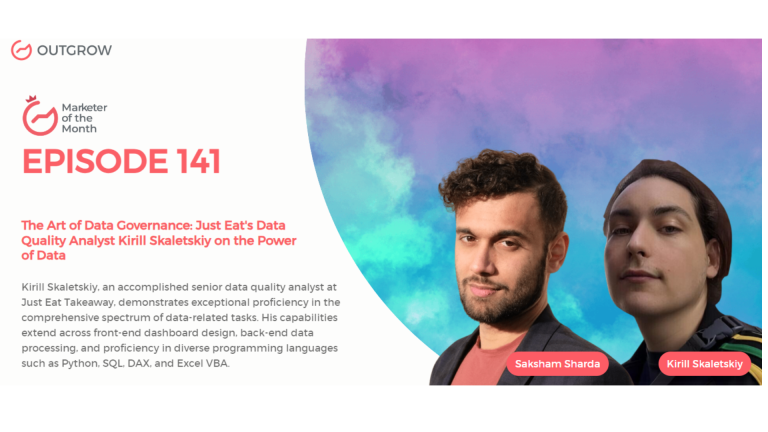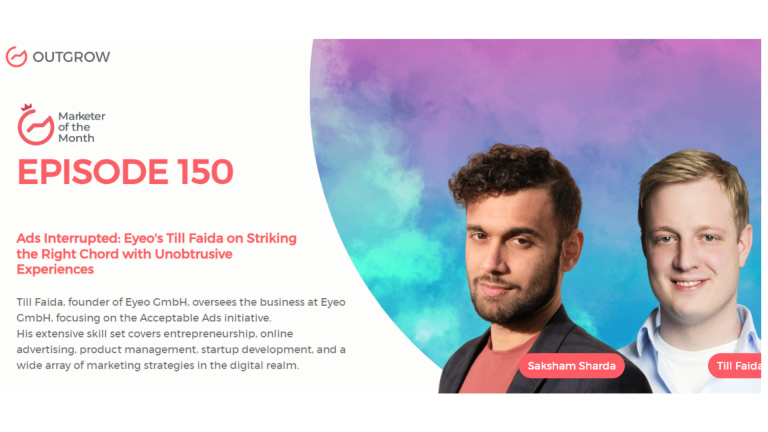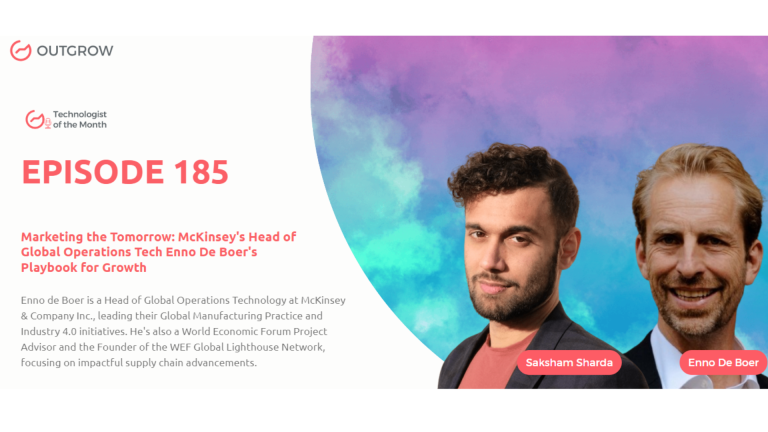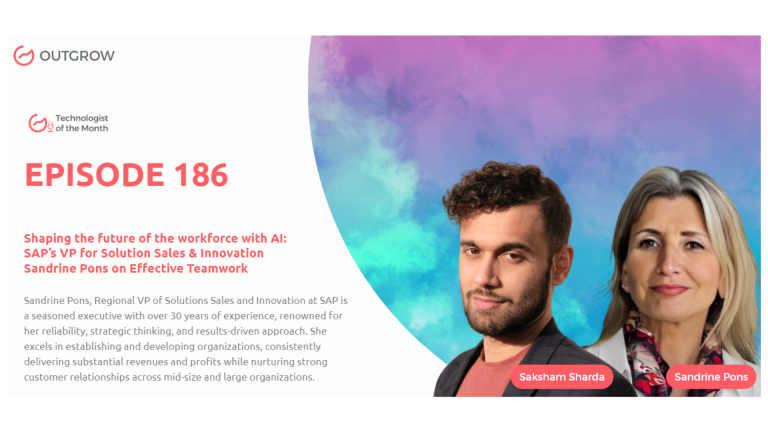Hey there! Welcome to the Marketer Of The Month blog!
We recently interviewed Anca Iordanescu for our monthly podcast – ‘Marketer of the Month’! We had some amazing insightful conversations with Anca Iordansecu and here’s what we discussed about-
1. Understanding liquid AI: Exploring the dynamics of time series-based AI predictions.
2. Exploring career evolution: From teaching to innovating in software development and technology at Ericsson.
3. Lessons from mistakes: Unveiling oversights in voice-over IP development and market readiness
4. Ikea’s technological innovations for immersive customer experiences.
5. Harnessing data insights: Balancing personalization and privacy for future store development.
6. Driving diversity in tech: Advocating for inclusivity and innovation through women in tech alliance and integrating accessibility for all in Ikea’s design philosophy.
7. Staying ahead: Strategies for staying informed in the dynamic tech landscape.
About our host:
Dr. Saksham Sharda is the Chief Information Officer at Outgrow.co. He specializes in data collection, analysis, filtering, and transfer by means of widgets and applets. Interactive, cultural, and trending widgets designed by him have been featured on TrendHunter, Alibaba, ProductHunt, New York Marketing Association, FactoryBerlin, Digimarcon Silicon Valley, and at The European Affiliate Summit.
About our guest:
Anca Iordanescu, PhD in Computer Science, is the VP of Engineering at IKEA Retail, spearheading the creation of future stores. With a background in digital transformations and over 15 years in the telecom industry, Anca is known for her role in modernizing IT landscapes. Recognized as a top woman in tech, she actively promotes diversity and mentorship, co-founding WomenInTech and chairing Women in Tech – Malmö.
EPISODE 165: Tech Tides and Retail Rides: Ikea’s Vice President of Engineering Anca Iordanescu on Stores of the Future
Table of Contents
The Intro!
Saksham Sharda: Hi, everyone. Welcome to another episode of Outgrow’s Marketer of the Month. I’m your host, Dr. Saksham Sharda, and I’m the creative director at Outgrow. co. And for this month we are going to interview Anca Iordanescu, who is the VP of Engineering at IKEA Retail.
Anca Iordanescu: Great to be here. Thank you.
Don’t have time to read? No problem, just watch the Podcast!
Or you can just listen to it on Spotify!
The Rapid Fire Round!

Saksham Sharda: So, Anca, we are going to start with the rapid-fire round. Just to break the ice, you get three passes. In case you don’t want to answer the question, you can just say pass. But try to keep your answers to one word or one sentence only.
Anca Iordanescu: Yeah.
Saksham Sharda: Alright. So the first one is, at what age do you want to retire?
Anca Iordanescu: Oh, never. I don’t want to retire from learning and being curious.
Saksham Sharda: How long does it take you to get ready in the mornings?
Anca Iordanescu: Very quick.
Saksham Sharda: Most embarrassing moment of your life.
Anca Iordanescu: Falling on the stage.
Saksham Sharda: Favorite color?
Anca Iordanescu: Green.
Saksham Sharda: What time of day are you most inspired?
Anca Iordanescu: Mornings.
Saksham Sharda: How many hours of sleep can you survive on?
Anca Iordanescu: Many hours of sleep. I like to sleep.
Saksham Sharda: Fill in the blank. An upcoming technology trend is ____.
Anca Iordanescu: Liquid AI.
Saksham Sharda: The city in which the best kiss of your life happened.
Anca Iordanescu: Manchester.
Saksham Sharda: Pick one- Elon Musk or Mark Zuckerberg.
Anca Iordanescu: None of them.
Saksham Sharda: The biggest mistake of your career?
Anca Iordanescu: Many small mistakes. All the time.
Saksham Sharda: How do you relax?
Anca Iordanescu: Classical music or calling my mom.
Saksham Sharda: How many cups of coffee do you drink per day?
Anca Iordanescu: Too many.
Saksham Sharda: A habit of yours that you hate?
Anca Iordanescu: Drinking too much coffee.
Saksham Sharda: The most valuable skill you’ve learned in life.
Anca Iordanescu: Being genuine and kind.
Saksham Sharda: Your favorite Netflix show.
Anca Iordanescu: I don’t watch Netflix.
Saksham Sharda: Okay. One-word description of your leadership style.
Anca Iordanescu: Leadership. It’s a network, not a hierarchy.
Saksham Sharda: The top priority in your daily schedule.
Anca Iordanescu: To get most of the things done quickly so I can focus on my dreams.
Saksham Sharda: An ideal vacation spot for relaxation.
Anca Iordanescu: The top of the mountain is an empty beach together with my family or my husband.
Saksham Sharda: A Key factor for maintaining a work-life balance,
Anca Iordanescu: Being very structured and fast.
Saksham Sharda: A memorable career milestone.
Anca Iordanescu: When I start coding for the first time.
The Big Questions!

Saksham Sharda: Okay. Well, that’s the end of the rapid fire. You did very well. No passes. So that was great. What is liquid AI? Tell us more about liquid AI.
Anca Iordanescu: Liquid AI, it’s a new AI where instead of being compared to generative AI or deterministic AI, where you are based on static data, the liquid AI is based on time series and can predict the next protect the text movement on the next happening based on the time series. And I find it very interesting. It’s a lot like in the beginning and I’m learning about it, and I want to understand how we can use it cleverly and what can be done with it.
Saksham Sharda: That’s interesting. Okay, so let’s go onto your career in general. So you’ve held key leadership positions in various sectors from telecom to digital transformation, and now as VP of engineering at IKEA. How have these diverse experiences shaped your perspective on technology’s role in shaping the future?
Anca Iordanescu: And I, if everyone is asking when someone is asking me about my career, and I would say I’m a technologist, my, if I have to look down deep down into my heart, it is like, I’m so curious about technologies. I’m always looking to learn more and to discover things. And that started again, in my life. And just to give an example, in my career, I didn’t start as a developer. I started teaching at the university. That’s how I started. And it just happened that someone said, do you want to try to work as a software developer at the company? And I said, ah, why not? I, you know, going from a very theoretical way into hands-on, it was always interesting to see how I can apply. And I ended up being at Ericsson. I had no clue at that time about telecommunication, except that, you know, at that time that was the first mobile phone appearing. I didn’t know anything. And that’s when I got in love with the hardware and software because I, I, we were taken to do some training and I started to learn how to write code. Of course, I knew how to do code, but to write devices, switches, code, and actually how to put the code on PCBs and how to mount a switch. And then you could see the whole thing working. You can see that you can make a phone call and then you, or you know, your hands are there. So I just got impressed. I would say that was my first aha moment and I fell in love. And then, you know, different technology came from my hand from GPRS on mobile phones. Even, you know, working with others to discover new technologies, making the first wifi, the first Bluetooth, the first GPS, the first display touch phone. And so, this kind of, kind of just grows in me. So while I was working in telecom, they opened my, I would say, my curiosity for learning more. And that’s what shaped me. Because as a leader, I’m always a leader. That is not only about leadership, I’m also dreaming about innovation, and how we bring innovation into our lives in any sector I’m working in.
Saksham Sharda: So is there any particular instance that comes to mind, a particular project from your career that significantly influenced and made you think about your approach to integrating technology for all future development? Is there anything memorable that comes to mind?
Anca Iordanescu: And I would say now since you are asking the fire, fire questions about my biggest mistake, one of the things that in a way, see as a big mistake, but also as a big learning. Again, many, many years ago, I was part of the team discovering what we call the generic access network. This was the first type of voiceover IP. So we were kind of the first inventors of the voiceover IP using at the time GPRS technology and a small box, which was enabled with Bluetooth. And we believe in that. That was something that we said, yeah, that will be, you know, people can do handovers. They come home that you don’t, it was the internet, you know, voiceover internet. And then there, we were preaching about Bluetooth. Another company said, yeah, maybe we should use wifi on the phones. And we were laughing while talking on the phone. Now think about how many years ago, it generated so much heat that you’ll never be able to have a phone by your ear because it’ll just burn your ear anyway. So we believed in Bluetooth. And I have been trying to sell this idea. We went to a lot of, so operators, mobile operators in France, Denmark, and Sweden to buy the technology almost there. But it didn’t fly. We have failed because again, WiFi’s coming, and the technology market was not ready. But, what we’ve learned, we have put the first actual seed of voice over the internet. So we have been thinking about that. And that was many, many years before. You know, WhatsApp or Zoom, whatever happened today on the phone. So that was kind of a big failure, I’m gonna say mistake, but a big failure, failure while learning to move forward.
Saksham Sharda: And, this entire transition now, a lot of companies that were manufacturing mobile phones don’t even manufacture them anymore. How have you seen this change happen firsthand at a lot of companies? How do you feel about that?
Anca Iordanescu: Oh, I think in a way, very painful because being in this telecom world where you kind of build, you know, there was a very, I would say an atmosphere where a lot of creativities happening and big dreams and to, to make, to see that, you know when Apple came, I can’t remember, no one believed that you know, apple will take over in such a big, and then like Sony, Erickson, Sony Mobile at that time was the third in the, in the market. And then immediately declined because we didn’t foresee the future in the right way. We didn’t look at the customer’s needs. And no matter what to say actually at the time Sony Ericsson had the first touch phone, we had it in our hands. There were lots of mistakes. We didn’t work properly, but we had it. But I didn’t know how to use that opportunity at that time. So it was a little bit of being strategic, being a way to understand the customer needs, being in knowing how to market things. We were, you know, and probably also big, very technology people. We talk about, you know, people that know technology, they don’t think about it. But how, what about customers, Customers are always interested in technology or more into what they can do with the technology. That’s another big, big mistake. Seeing how things are going down. And then for me was very sad because I liked that area, and I wanted us to, at least since I’m part of Sweden, where we have done this we see the decline was not very happy. Lots of people working there kind of, you know, had to move to another and to bring their creativity to other industries. Yeah.
Saksham Sharda: So speaking of this kind of prediction and being able to predict where the market will go in the future, your work at IKEA involves creating stores of the future. Now, can you share some insights into the technological innovations or strategies you are implementing to revolutionize the retail experience?
Anca Iordanescu: And also, so Ikea blue boxes, everyone knows the Ikea blue boxes. And we are famous for the way we make our customers shop. What we have forgotten a little bit was the technology in the store. So you can see that IKEA stores are not very technologically advanced. Still, you don’t have a specific, for example, if I take customers, we don’t have an app that is fitted for the store environment to show location, to discover the product, to tell the story about the product. We call it contextual storytelling, to help you to understand your projects. That is because we know that customers start their journey at home looking, searching for things, and then connecting, and they come to see and get inspired in the store. So we kind of lost all this kind of creating the visit at the store as a big moment. So if I take the whole customer view of the store, what we are trying to do is kind of how are we going to meet our customer in a better way in the store? And we start with d with all the channels, because we talk about being an omnichannel retailer. We talk about, you know, you come with the app and you want to understand exactly what’s my project, what are, how can I find faster? What is inspiration? What are the marketing, what are, you know, offers When I enter, what is my closest store? How can I click and click and collect all these things about convenience? Then we have the second one. It’s about an immersive experience. How do I get into the store and a different type of format store? For example, we have big boxes, but we have also small formats which are coming in the city center. There. You cannot talk about the entire display. So how can you use technology, immersive technology to be able to show the designs, the range, to let the customer explore? So we have, this is immersive. And then the third layer is really about the customers. They don’t want to come through their apps, how we offer personalized assistance in the store, in the big boxes through our kids. And how can you, again, connect and transfer easily from your phone, how can you pay, how can you check out pay, and so on? So that’s one part of the dream. And the biggest one, of course, is about immersion. And what are we doing with that? The second pillar, it’s about coworkers. We know that the success of our customers, or our customers say that they are successful in the store when coworkers serve them better, meaning we need to free up time for our coworkers to serve our customers. We need to remove all the manual tasks and that can be optimized to make sure that we can free up them to serve the customers. So looking again, into automating the shop floor, looking into automating manual tasks, looking into offering our coworkers easy tool mobile devices with, if you see today our coworkers are using a lot of tools, simplifying the way they can access our to, to our systems. So that is, and then so that’s the second one. The third one is a little low around robotics, in the store to, for example, automatically update the availability of the different products where the products are located. You have different, what we call design rooms, how you can, if I want to buy them, oh, everything is there, how do I get there and scan and go, lots of things around, you know, shop floor automation.
Saksham Sharda: And to what extent are data-driven insights playing a pivotal role in shaping these futuristic stores? Like how do you balance customer personalization with privacy concerns and data in this context?
Anca Iordanescu: So if I take a lot of data, it’s all over the place. We are still struggling in, I would say, creating the right data object. We call it 360 objects. So we have around 360 data objects around the store of 360 data objects around cust coworker. So if I take data about CU customers in the store, of course, you can anonymize a lot of data so you don’t get into the privacy thing. And we are working now on how to create a good digital twin of the store with different sensors. We have not cracked the code. I know the digital twin technology is there, but it’s, what we are looking at is more than just a digital twin as such, what sensor, where do we put cameras, and how can we create a digital reality of our store? So first we can understand what’s happening in the store and get data, and that’s the most important second, that’s why I was talking about, you know, prediction and AI is not only to predict what will happen in the next and how to, so we can to foresee the things and take actions in advance before happening. But also what we are looking into, for example, can we use AI, digital twins to predict the shape of the future of the store? What, how others have been organizing, are we structured well enough? It’s us, all our maze when you are going is bringing the best out of our store. And so, but we are not yet there. So the camera sensor collects data about the store and customers. And then, of course, we have a lot of data about how customers are using our app. And of course, the moment you use your app, you have given your privacy you know, acceptance to be part of the data. If you don’t, you can give your consent or not. Another thing we want to use, but that’s just a, you know, a seed that I’m planting to, we want to increase the usage of our app, and in the same way also by collecting data. So people who are consenting to use our app, we want to use them to run their data, to understand how we can do a better store setup. How can we better meet our customers?
Saksham Sharda: And when it comes to personnel, the people who are gonna be working at these stores of the future, you’ve been actively engaged in programs promoting diversity and mentorship, particularly for women in tech. How important is it, do you think, to foster inclusivity and diversity within the tech industry? And how can organizations actively contribute to this cause?
Anca Iordanescu: And this is a very dear topic to me because I’m the founder of Women in Tech Alliance and as a founder, we have a mission. And our mission is to have 1 million women join and thrive in technology in Europe by 2030. I think it’s a very bold goal. It probably will be very hard. We are just at the beginning. So as women in tech alliances, we are connecting individuals, nonprofit organizations, or companies in the private sector, the public sector, and academia, trying to create this environment where women can join and thrive. And we see a lot of women struggling to get and also get accepted into the industry. Why I think this is so important is, like, I believe that innovation cannot happen without diversity being the basis of any movement forward. It’s having a diversity recognizing that different cultures, different genders, and not, I’m not only talking to women, of course, now I have, but I’m also around women because it is like, I see like a first step to be taken. But we also address all groups or not privileged groups, and we welcome them to join us. But I think without different cultures, different backgrounds, and different genders, we cannot foster innovation. This is so critical. This is so important. And different and different opinions are so important. And I’m promoting, I’m an ambassador, and every time I meet the manager’s leaders in higher positions, I am advocating the need of creating a better organization with, you know, inclusiveness at heart. At IKEA, we are still 34% women in technology, far from 50-50, but we are doing good compared. But after you go into the organization on a higher level, you see a silicone ceiling, see a ceiling. So I am still trying to get this money set to change and to see more women coming to my level and even above my level.
Saksham Sharda: Do you have any idea, go ahead?
Anca Iordanescu: We have many. I would say, if you ask me what activities we are doing, we do have a lot of networking, a lot of mentorship, a lot of podcast sharing, a lot of personal branding education for women from a technology education, but also to how to write your CV. Also, education for the company, how to create, and how you should create your diverse organization. So this is the event we are organizing.
Saksham Sharda: And so do you have any interesting memory or success story or an instance that comes to your mind around fostering diversity that led to some benefits or an innovative solution that normally wasn’t expected, but everyone was kind of surprised with the result or any memory? It doesn’t have to be like a success story, but anything interesting that caught your attention because of the diversity promotion.
Anca Iordanescu: Just I’m thinking of course. I think, from an iCare perspective now, I’m trying to see if, to put it in the context, context again. When we look at our customers, and also our coworkers, we want to, we want to create this kind of innovative experience. So we make it easy for everyone, even people with disabilities to use our tools. And how we got more, more out, more from the outside view on how we should do it. We met with our colleagues they had on the team, one of the people who had some disability, and they started to share how they see from their side, how our tools are supporting their disability. And we understand we are far away from being inclusive and, and looking to all. So with that in mind, we have started to adopt it. We are still not a hundred percent ready. That’s why it was, I didn’t want to present it as a success story, but we are very aware of the needs. We want to understand from their perspective, and we want to put everything, when we design any tool, inclusiveness, equality, diversity, and inclusion in our design, a little bit fluffy. But that’s how we learn it. Just listen to our coworkers who have issues and integrate and make them happen in our environment.
Saksham Sharda: I mean, it is still a work in progress. So I guess we’ll see the results in a slow manner over time.
Anca Iordanescu: Yeah. Maybe again, about slow, you have to think, IKEA has approximately 500 stores, so rolling out a solution across the globe is something slow. So we are pretty slow in seeing the impact immediately because it’s not about one store, it’s about many stores, and it takes a lot of effort to see all over the globe.
Saksham Sharda: So speaking of transformation, then, digital transformation has been a key focus of your career. What are the primary challenges you’ve encountered when spearheading such large-scale changes, and how do you navigate these challenges effectively?
Anca Iordanescu: Yeah, I think the biggest and the biggest challenge is the mindset of the overall company. It is not usually the technology people. Digital people are very well-anchored in technology. They see where the trends are going, and they dream about how to move it to get that going. You need a full buy-in from the entire company and acceptance to be recognized that, again, we are heading this transformation. So mindset and acceptance and probably understanding that this is a very difficult transformation and that it’ll get worse before we’ll get better. So being you know, resilient, is driving that transformation, having patience, but also not giving up on the big dreams if your transformation by such requires to make a change to create, to be disruptive in a way. So if you just think like one year ahead, you don’t make a change. You need to think about five years ahead, 10 years ahead, and even, where you want to go. What is the new business model? What will happen? Why do you need to transform digitally, and how technology will support the transformation? What will be the role of retail and why do we need to change? So that’s kind of when you set it up. And then when you go into the transformation, again, resilience, because it’s very tough. It is, like we say, changing the airplane engine while you are flying. It has a lot of feelings. You need to let go as an organization. Many things you have done in the past, and then sometimes there are, as with any change, there are promoters, there are people that are keeping you back. Some want to move forward. So again, caring for the people’s mindset shifts and, you know, being able to speak up where you want to go and bring your passion into people so they can follow you.
Saksham Sharda: How do you manage resistance to change within teams and organizations? What are the best approaches you’d have to recommend to other tech leaders?
Anca Iordanescu: Yeah, so it’s all about communication, I think. And that’s all I said. It’s about passion, and making the change together because resistance will be there. I also think it’s important to find the ones that are willing to move ahead and change. It is like the trenders, you know, it’s one going ahead, like a wolf alone, going ahead, and then you, the first followers are coming and then the whole wolf pack will move. But, it’s talking and talking and communicating and explaining and about, I think it’s very important to repeatedly communicate where you want to go. There will always be people who will not want to follow, and there will always be some people who think that this is not for them. And then there are two ways of doing them. Either you accept that and then you minimize, you know, the impact on the organization, or you have a very open dialogue explaining and changing it, or you take them with you trying to take you with them. Some, you’ll never be able to do any of this, so you have to let go. And there will be personal choices that some people need to make if they are going to support the change or not. But I would say most of the, you know, if you are good in communicating your vision if you’re good to show the step if you include most of the team into the change, so you don’t do like an exclusive change, you do a change where people see the benefit, they see what they can learn, they see what is in it for, for me. Mostly, it’s pretty successful. Again, 80%, you know, like in software we do 80% good, not a hundred percent.
Saksham Sharda: And so speaking of how rapidly change happens in the industry, especially in tech, and, the pace is so fast around how do you keep track of all the latest trends and things happening? Are you subscribed to some newsletters? Where do you get your information from?
Anca Iordanescu: Unfortunately, I’m pretty hectic myself, of course. I like to read and I’m curious, but I’m not very structured into that meaning I, of course, read the news. I even look at LinkedIn and sometimes they’re so interesting. You know, people are just linking things and I just get, oh, I read about it and then I go and read more. But also I’m attending as a speaker, lots of conferences and just being there and listening to other speakers and going around, you know, and see the things that I always come with a lot, a big map of a lot of leaflets and I read about, but also for example, I take courses again, not as, as with the frequency I want, but when I feel like I if I want really to move forward some things, I always say that you need to be very well technically prepared. You cannot do things if you don’t know what you’re talking about. So I’m taking courses, I’m starting to push myself because I don’t have a lot of time in the world and I’m doing many things, but I want to take more courses, especially in technology, like learning about what’s coming, what’s cooking and then yeah, talking to people. What I have also learned is that I like to get around a lot of very clever engineers who just inspire me with their ideas so we can brainstorm more different things. So it’s a lot of palettes, but then, I think it’s more about being curious, and then things will just open to you.
Saksham Sharda: Is that how you learned about liquid AI?
Anca Iordanescu: Yeah, actually that’s what I’m looking for, we were talking about a new idea, and then I started with something and then he said, no this is not a good idea. Read about that. And I said, what is this liquid AI? And then I say, I Google quickly. And they said it’s an AI doing music. Generational is What are you talking about? No, go and read. And then I got links, and then I started reading and, okay, and then already, now I have an idea what, how can we do it? So it’s like connecting and then I’m really curious to learn more about it.
Let’s Conclude!
Saksham Sharda: Thanks, everyone for joining us for this month’s episode of Outgrow’s Marketer of the Month. That was Anca Iordanescu, who is the VP of Engineering at IKEA Retail.
Anca Iordanescu: Great to be here. Thank you.
Saksham Sharda: Check out the website for more details and we’ll see you once again next month with another marketer of the month.

